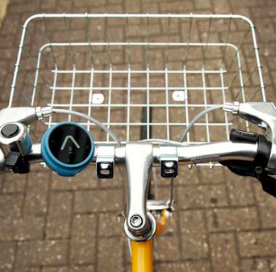The intuitive Beeline cycle navigation device is hitting the market for the first time this month. Kieran Howells sits down with creator Tom Putnam to discuss how he thinks the unit will transform the process of city cycling.
As we see each month in the pages of BikeBiz, the companies that invest in the latest technology, look after their communities and, most importantly, create the products that people want, are the ones that not only survive the fluctuations of the market, but actively thrive in what is an open-minded and innovative trade. The market-wide willingness to embrace new tech could very well be attributed to various elements. Bikes are a never-ending source of sustainable travel; they are easy to store, easy to carry and simple to customise, but the central theme that runs throughout the business is the simple fact that cycling is fun. It’s very hard not to fall in love with the unlimited freedom and rush of endorphins that comes with riding a bike, and that is the very reason that companies like Beeline exist.
The product itself focuses on two things. Firstly, in the cobbled streets that make up British cities and on the packed and dangerous roads that surround them, concentrating on any kind of satellite navigation device is potentially hazardous. Secondly, traditional satellite navigation systems can be hard to follow, and generally stressful to operate. These issues are the exact problems that faced young entrepreneurs Tom Putnam and Mark Jenner when trying to navigate London for a lunch meeting. Both discovered just how practically ineffective traditional satellite navigation devices were in this situation; after finally finding each other, they decided to do something about it.
“It was just a problem Mark – my co-founder – and I had ourselves, combined with the fact that we both wanted to start something we were personally excited about. We kept getting lost and hated having to pull out our phones to look at maps. We started out meaning to just put compasses on our bikes, but we thought we could get smarter than that.“
The pair set about discussing the criteria for their new device. They decided it needed to be simple and basic in design, whilst delivering the most effective direction possible. “We needed something that was really quick and easy to set up and just did what it needed to do really simply. There are plenty of navigation options on the market that while very clever, are quite complex, expensive and take a long time to set up; that is not what you need when riding.” They settled on the basic principle of a compact handlebar-mounted device that strips back navigation to the basics in order to make navigation simpler, but also to encourage exploration on urban streets.
Having ascertained the functions that they believed the device needed to fulfil, Jenner and Putnam set about creating the basis of what would become the first-ever Beeline device. “We started making the hardware ourselves after watching a lot of YouTube videos. Mark spent the majority of his three months’ leave teaching himself to code – the end result was a working prototype. It was a large block of wood with wires sticking out of it, but it was a working prototype! Progress slowed after this; we had to do some freelancing to make ends meet and were getting frustrated. That’s when we decided to get external help and met Map Project Office – a team of industrial designers. We agreed to spend much more money than we actually had, but backed ourselves to find the investment. Trajectory went up, the speed of development increased and all of a sudden we were looking at a saleable product!”
The creators now had the makings of a unique device, and with the help of a newly-formed team bolstered by designer Sam Lucas and developer Marc Baldwin, they set to work refining the technology into a sleeker form. Along with the simple and
intuitive silicone casing, which not only protects the device, but also acts as a secure handlebar clasp, the design team utilised technology watching a lot of YouTube videos. Mark spent the majority of his three months’ leave teaching himself to code – the end result was a working prototype. It was a large block of wood with wires sticking out of it, but it was a working prototype! Progress slowed after this; we had to do some freelancing to make ends meet and were getting frustrated. That’s when we decided to get external help and met Map Project Office – a team of industrial designers. We agreed to spend much more money than we actually had, but backed ourselves to find the investment. Trajectory went up, the speed of development increased and all of a sudden we were looking at a saleable product!”
The creators now had the makings of a unique device, and with the help of a newly-formed team bolstered by designer Sam Lucas and developer Marc Baldwin, they set to work refining the technology into a sleeker form. Along with the simple and intuitive silicone casing, which not only protects the device, but also acts as a secure handlebar clasp, the design team utilised technology similar to that seen on devices such as Amazon’s successful Kindle, and opted for a sunlight readable backlit e-paper screen. The benefits of this included crisp, clear instruction, and bare minimum power usage. “It’s simplicity rather than a richness of features that we’re most proud of. In a world of ever more complex technology that sucks you in and takes you out of real life, we’ve dared to be simple; not over complicating, but giving you the little boost you need to see and engage more with the world.”
The team fully embraced modern startup culture and utilised the steadily growing community of eager cyclists that built up around the device to fuel a successful Kickstarter page, which garnered positive feedback from fans. “We hit our Kickstarter goal pretty early on, after which we generated quite a bit of press interest. The concept of this different form of navigation – fuzzy navigation as we call it – seemed to resonate. Since then we’ve been nominated for a Beazley Design of the Year award at the Design Museum here in London, which is a huge honour. Most recently, we’ve been running BETA testing with some of our Kickstarter backers who have helped us to get the product ready for release. Despite a few glitches which we’ve worked to overcome, the testers are all fans of the product. All of them have really enjoyed riding with it!”
With the support of their community and significant crowdfunding behind the product, Jenner spent the latter part of 2016 in China, searching for a factory to begin production on the first full batch of Beelines. After several months of rigorous searching, a factory was found in early winter and production officially began. The device went on general sale on January 18th to very positive reviews. Having helmed the process from initial musings through to general sale, Putnam believes that the future looks bright for the Beeline team. “The journey doesn’t stop here. We’ve got lots of ideas up our sleeves as we continue to develop new features; our North Star will always be keeping that beautiful simplicity wherever we can, all while making journeys better for our customers.”
 BikeBiz Bicycle and cycling retail news
BikeBiz Bicycle and cycling retail news




